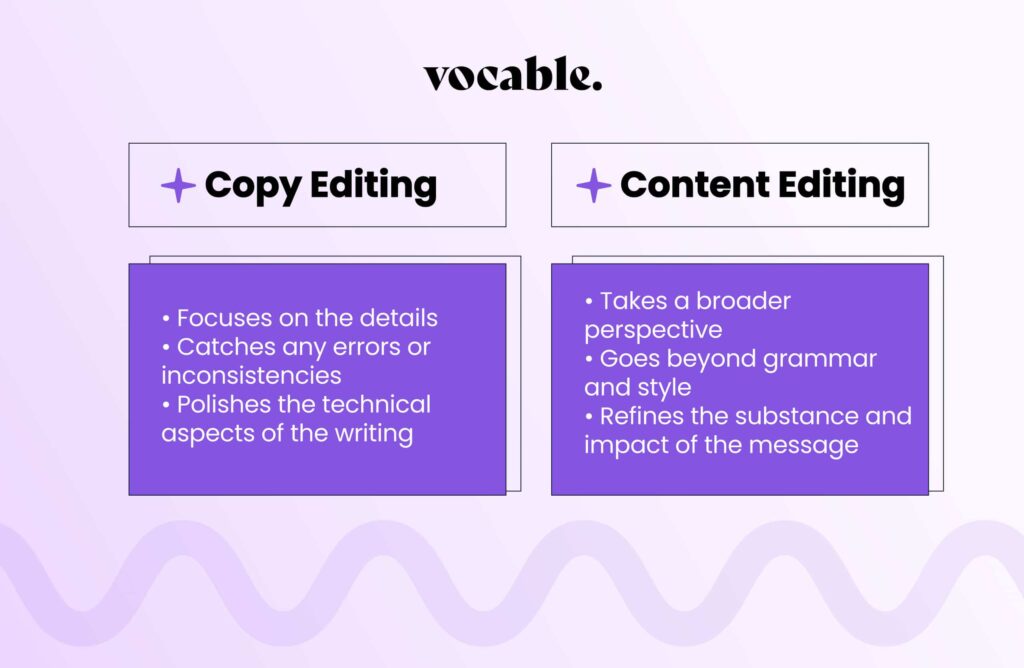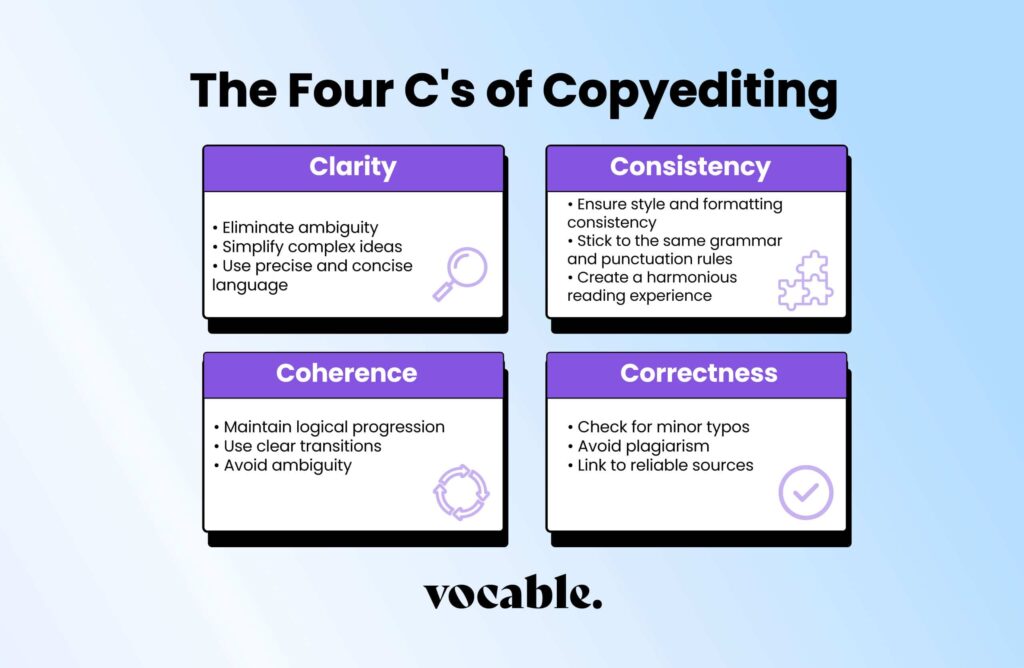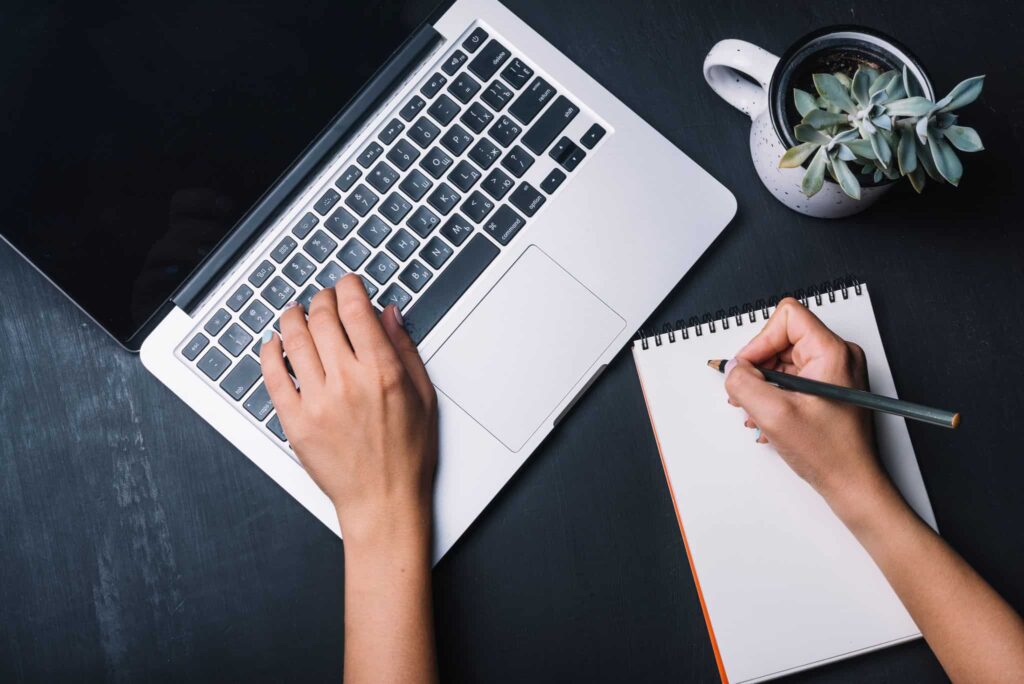That’s where content editing steps in to make all the difference.
It is the secret sauce that enhances readability and user experience, elevates your search engine rankings, and drives organic traffic. It’s the magic wand that polishes your words, ensuring they resonate with your target audience and captivate their attention.
In today’s online world, where competition is fierce and attention spans are fleeting, you can’t afford to overlook the power of content editing. Well-edited content is the bridge that connects you with your readers, conveying your message effectively and leaving a lasting impression.
In this informative guide, we’ll dive deep into the art of content editing. We’ll unravel the key ideas and best practices that will empower you to elevate your content to new heights.
So buckle up and get ready to discover how editing content can sharpen your online success!
What Is Content Editing?
From good to outstanding – that’s the ultimate goal of content editing. It’s the process of refining and perfecting your content to ensure it achieves its intended goals. Whether you’re a content editor, a writer, a digital marketer, or someone concerned with quality, understanding the essence of web content editing is essential for creating compelling and impactful results.
At its core, content editing involves carefully examining for clarity, coherence, and effectiveness. It goes beyond basic grammar and spelling checks, delving into the realm of structure, flow, and engagement. It’s about shaping your words to resonate with your target audience and elicit the desired response.
Back to the question, what is content editing?
The objectives of content editing are multi-fold. Firstly, it aims to enhance readability by eliminating jargon, simplifying complex ideas, and creating a smooth reading experience. Secondly, it seeks to improve user experience by organizing information logically, incorporating engaging visuals, and optimizing formatting.
But that’s not all! Editing content also plays a crucial role in boosting your search engine rankings and driving organic traffic. By optimizing your content for relevant keywords, refining meta tags, and ensuring proper use of headings, content editing helps search engines understand and rank your content better.
Main Types of Content Editing

When it comes to content editing, it’s not a one-size-fits-all approach. Different stages of the content creation process require different types of editing to ensure your words shine and resonate with your audience. Let’s explore the main types of content editing and how they can elevate your content to new heights.
→ Developmental Editing
Developmental editing focuses on the big picture. It involves shaping the overall structure, flow, and organization of your content. This type of editing looks at the clarity of your message, the logical progression of ideas, and the effectiveness of your storytelling. Developmental editing helps ensure your content has a strong foundation and resonates with your target audience.
→ Copy Editing
Copy editing dives into the nitty-gritty details of your content. It involves fine-tuning your words, sentences, and paragraphs for clarity, grammar, spelling, and punctuation. Copy editing ensures your content is error-free, consistent, and polished. It’s like giving your content a final coat of paint to make it shine.
→ Line Editing
Line editing focuses on the beauty of language. It involves refining your writing style, improving sentence structure, and enhancing the overall flow and rhythm of your content. Line editing adds a touch of elegance to your words, making them captivating and memorable.
→ Proofreading
Proofreading is the final step before publishing. It involves meticulously reviewing your content to catch any remaining errors or inconsistencies. Proofreading ensures the content is flawless, creating a professional and credible impression.
Copy Editing vs. Content Editing
When it comes to editing, two terms often come up: copy editing and content editing. While they may sound similar, they serve distinct purposes in the editing process. Let’s uncover the key differences between these two types of editing.

Copy editing focuses on the finer details of your content. It involves polishing your words, sentences, and paragraphs to ensure clarity, grammar, spelling, and punctuation. Copy editing is like giving your content a thorough proofread, catching any errors or inconsistencies that may distract or confuse the readers. It’s about perfecting the technical aspects of your writing, making it error-free and professional.
On the other hand, content editing takes a broader perspective. It examines the substance and effectiveness of your content as a whole.
Content editing goes beyond grammar and style to evaluate the clarity, coherence, and relevance of your message. It assesses the structure, organization, and logical flow, ensuring the content aligns with your goals and resonates with the target audience. Content editing aims to refine the core elements of your content, making it engaging, informative, and persuasive.
In simpler terms, copy editing polishes the surface of your content, focusing on language mechanics, while content editing delves deeper, refining the substance and impact of your message.
The Four Cs of Copyediting

When it comes to copyediting, there are four essential elements to keep in mind. Known as the Four Cs of Copyediting, these principles serve as a guide to ensure your content is polished, error-free, and ready to captivate your readers. Let’s delve into the Four Cs and uncover their importance in the copyediting process.
1. Clarity
Clarity is the cornerstone of effective communication. As a copyeditor, your role is to ensure that the message you convey is crystal clear to your audience. This involves eliminating ambiguity, simplifying complex ideas, and using precise and concise language. By striving for clarity, you help readers effortlessly comprehend your content and avoid confusion.
2. Consistency
Consistency is key to maintaining a professional and cohesive tone throughout your content. As a copyeditor, you need to ensure that your language, style, and formatting are consistent from start to finish. This includes checking for consistent spelling, grammar, punctuation, and capitalization. Consistency creates a harmonious reading experience and enhances the credibility of your content.

3. Coherence
Coherence refers to the logical flow and organization of your content. A well-structured piece makes it easier for readers to follow your ideas and arguments. As a copyeditor, you must ensure that your content has a logical progression, with clear transitions between paragraphs and sections. Coherence allows readers to navigate your content effortlessly and absorb information without feeling overwhelmed.
4. Correctness
Correctness is the foundation of impeccable content. It ensures that your grammar, spelling, punctuation, and usage are error-free. As a copyeditor, you play a crucial role in catching any mistakes that may have slipped through. By upholding correctness, you uphold the professionalism and credibility of your content.
Strategies to Unlock the Secret to Stellar Content
1. Establishing a Solid Editing Process
When creating stellar content, having a well-established editing process is crucial. It sets the foundation for refining your content and ensuring its quality.
Here are three key strategies to establish a solid editing process:
Streamlining the Editing Workflow
To maximize efficiency, streamline your editing workflow by breaking it down into manageable steps. Start with a comprehensive review of your content, focusing on clarity, coherence, grammar, and style. Then, move on to fine-tuning each section, polishing sentences, and eliminating errors or inconsistencies. By following a systematic approach, you can ensure that no aspect of your content goes unnoticed.
Setting Editing Goals and Priorities
Before diving into the editing process, set clear goals and priorities. Identify the specific elements you want to enhance or address in your content. It could be improving readability, strengthening the argument, or ensuring brand consistency. By establishing these goals, you can direct your efforts effectively and ensure that your editing aligns with your content’s purpose and target audience.

Ensure Having Style Guides
Style guides are invaluable resources that provide guidelines for grammar, punctuation, formatting, and more. They help maintain consistency throughout your content and ensure a cohesive and professional tone. Whether you follow a recognized style guide or create an in-house guide, having a reference to consult during the editing process will help you make informed decisions and maintain a consistent writing style.
Solution You Will Love: Vocable’s Style Guide tool can be a valuable resource in maintaining a consistent tone and voice across all your content.
2. Enhancing Readability and User Experience
Creating content that is both readable and user-friendly is key to engaging your audience and delivering a seamless experience.
Here’s how to reach this!
Improving Sentence Structure and Flow
Well-crafted sentences contribute to the overall readability of your content. Ensure that your sentences are clear, concise, and grammatically correct. Avoid long, convoluted sentences that may confuse readers. Instead, opt for shorter sentences that are easier to digest. Consider the flow of your content, using transitional words and phrases to guide readers smoothly from one idea to the next. This enhances the overall readability and comprehension of your content.
Image source: Smart-Words
Checking Grammar, Plagiarism Rates, and the Use of AI Content Generation
Grammar errors and plagiarism can undermine the credibility of your content. Utilize grammar checkers and plagiarism detection tools to catch any mistakes or instances of duplicated content. Additionally, exercise caution when using AI content generation tools to ensure that the generated content aligns with your brand’s voice and meets the quality standards expected from your audience.
Simplifying Complex Concepts and Removing Jargon
Make your content accessible to a wide range of readers by simplifying complex concepts and avoiding unnecessary jargon. Use clear and concise language that your target audience can easily understand. Break down complex ideas into simpler terms and provide relevant examples to aid comprehension.
By doing so, you create inclusive content that appeals to a broader audience.
Reviewing Sentences for Clarity
Clarity is crucial for effective communication. Review your sentences to ensure they convey your message in a straightforward manner. Eliminate any ambiguity or confusion by using plain language and avoiding excessive wordiness.
Pro Tip: You may upscale your readability and use professional solutions that most advanced editors rely on. To consider the readability level of your content, you may integrate the Yoast SEO plugin into your WordPress and see real-time SEO stats and places for improvement. To begin with, the plugin also has a free online version for content analysis to provide you with basic insights.
Checking Content Authority
Establishing content authority is vital to building trust with your audience. Verify the accuracy of the information you present by fact-checking and referencing reliable sources. Ensure that your content is up to date and reflects the latest industry knowledge. By providing well-researched and authoritative content, you position yourself as a credible source of information.
3. Optimizing for Search Engines
To maximize the visibility and reach of your content, it’s crucial to optimize it for search engines. By implementing the following strategies, you can enhance your content’s SEO and improve its chances of ranking higher in search engine results.
Incorporating Relevant Keywords Naturally
Research and identify relevant keywords that align with your content’s topic and target audience. Integrate these keywords naturally throughout your content, including in headings, subheadings, and body text.
However, avoid keyword stuffing, which can negatively impact the readability and user experience.
Image source: Similarweb
Aim for a balance between optimization and maintaining the flow and coherence of your content.
Crafting Compelling Meta Tags
Crucial for SEO, meta tags also help to attract users and encourage them to click on your content in search engine results.
Optimize your title tag to include relevant keywords and make it enticing to encourage clicks. Craft a concise and compelling meta description that accurately summarizes your content and entices users to learn more. Well-optimized meta tags can significantly improve your content’s click-through rate.
Pro Tip: Of course, having your target keyword in the meta tags is crucial but don’t forget about the optimal lengths. Note that the ideal length for a meta title is about 50–60 characters. While the meta descriptions should vary somewhere between 150-160 characters.
Checking Whether It Aligns with the Search Intent
Understanding the search intent behind specific keywords is essential for content optimization. Analyze the top-ranking search results for the target keywords and identify the type of content that ranks well. This helps you align your content with the search intent, ensuring that it provides the information or solution users seek. By addressing the search intent effectively, you increase the chances of your content ranking higher.

Be Sensitive to Internal and External Links
Having backlinks plays a vital role in improving your content’s SEO. Internally linking to relevant pages on your website helps search engines understand the structure and hierarchy of your content.
Additionally, external links to authoritative sources can add credibility to your content. Ensure that your links are relevant, reliable, and provide value to your readers.
Additional reading: The Difference Between External and Internal Links
Incorporate Visuals
Content editing is not only about words but also includes visual aspects.
Contextual elements like images, infographics, and videos can enhance the user experience and engagement. Incorporate relevant visuals that complement your written content and provide additional value to your audience.
Optimize your visual elements by using descriptive file names and alt tags, which not only improve accessibility but also provide an opportunity to include relevant keywords.
4. Polishing Tone and Voice
The tone and voice of your content play a significant role in shaping the overall impression it creates on readers. By focusing on the following strategies, you can ensure consistency and effectiveness.
Ensuring Consistency in Tone and Brand Voice
Consistency is key in establishing your brand’s tone and voice. Define the desired tone, whether friendly, professional, conversational, or authoritative, and ensure it aligns with your brand’s values and personality. Once established, maintain consistency throughout your content to create a cohesive and recognizable voice. This consistency helps to build trust with your audience and reinforces your brand identity.
Tailoring the Content to the Target Audience
Who do you write for?
Understanding your target audience is essential for effective content creation.
Not everyone has the same level of perception. Some readers get triggered by the excessive use of idioms, while others find the text soulless without unique expressions.
Therefore, your text should resonate with a specific audience for its intended impact.
Consider your readers’ demographics, preferences, and needs when shaping your tone and voice. Adapt language, vocabulary, and writing style to resonate with your audience and make a genuine connection.
By tailoring your content to your target audience, you can establish rapport, engage readers, and encourage them to take the desired actions.
Easier said than done! Yet, Vocable’s Smart Entry Editor can assist you in customizing your content to match the preferences and expectations of your specific audience.
What Skills Does a Content Editor Need?
Being a content editor requires a unique set of skills to excel in the role. From refining the quality of content to ensuring its clarity and effectiveness, content editors play a vital role in shaping the success of any written material.
Let’s explore the key skills that make a content editor exceptional.
- Strong Writing and Editing Skills: Content editors should possess excellent writing skills with a strong command of grammar, punctuation, and style. They must be able to spot errors, rephrase sentences for clarity, and ensure consistency in tone and voice.
- Attention to Detail: Content editors have a keen eye for detail. They meticulously review every aspect of the content, from sentence structure to formatting, to catch errors and inconsistencies. Their attention to detail ensures the content meets high-quality standards and delivers a polished and professional end product.
- Communication Skills: Effective communication is vital for content editors. They collaborate closely with writers, providing constructive feedback and suggestions to enhance the content. They should be able to articulate their edits and recommendations clearly, helping writers improve their work and maintain a positive working relationship.
- Time Management: Content editors often work on multiple projects simultaneously, so effective time management will help in prioritizing tasks, meeting deadlines, and maintaining productivity without compromising the quality of their editing.
- Adaptability and Continuous Learning: The digital landscape is constantly evolving, and content editors need to stay updated with the latest trends and best practices. They should be open to learning new technologies, SEO content editing and techniques, as well as industry-specific terminology.
Navigating Common Content Editing Roadblocks
Consistency, redundancy, and creativity are common roadblocks that content editors often encounter. However, with the right strategies and tools, these challenges can be effectively addressed, resulting in high-quality and engaging content.
In this section, we’ll explore how Vocable’s all-in-one content editing platform can help content editors overcome these roadblocks.
The versatile functionality allows editors to use the Document Health feature to edit the copy and content further. You are free to experiment with various styles, proofread the text for any grammatical and readability issues, and upscale your ranking chances with SEO suggestions.
Ensuring Style and Consistency with a Style Guide
Consistency is crucial for maintaining a strong brand identity and delivering a seamless reading experience. Vocable’s content editing toolset offers a comprehensive Style Guide that allows content editors to define and enforce consistent style standards across all content. By utilizing the Style Guide, editors can ensure that the tone, voice, grammar, and formatting remain consistent, enhancing professionalism and impact.
Planning and Managing Workflow with Ease
Efficient workflow management is essential for content editors to streamline their editing process and meet deadlines. Vocable offers intuitive planning and project management features that enable editors to create and assign tasks, set priorities, and track progress seamlessly.
By having a centralized platform to manage the workflow, editors can enhance productivity and collaboration, ensuring the timely delivery of high-quality content.
Leveraging AI-Powered Templates and Entry Editor
Vocable’s content editing platform incorporates AI-powered templates and an entry editor, making content creation and editing more efficient. These intelligent content editing tools provide content editors with suggestions, automated checks for grammar and style, and streamline the editing process. By leveraging AI technology, editors can save time, improve accuracy, and focus on enhancing the creativity and impact of the content.
Collaborating with the Team for Seamless Alignment
Collaboration is key to successful content creation and editing. Vocable’s platform facilitates seamless collaboration by enabling content editors to work closely with writers, designers, and other team members. Through real-time commenting, version control, and shared access, editors can ensure everyone is on the same page, resulting in cohesive and well-coordinated content.
Final Observations
Content editing plays a pivotal role in the success of online content. By ensuring readability, optimizing for search engines, and polishing tone and voice, content editors elevate the impact of written material. Remember, consistency, clarity, and creativity are key to engaging and converting readers.
Don’t forget to implement the strategies discussed in this guide to unlock the true potential of your online content. And for a comprehensive and efficient content editing experience, consider utilizing Vocable’s versatile content management platform. With Vocable, you can streamline your editing process, enforce consistency, and collaborate seamlessly. Enhance your online success with the power of content editing and Vocable.
Join Vocable today to become the luckiest one and test Vocable’s power among the firsts!





